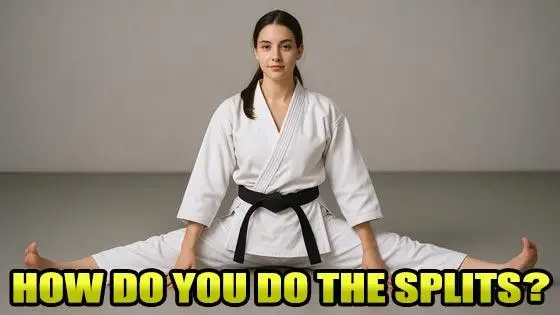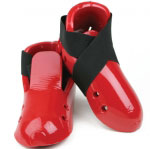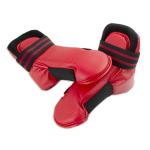Martial Arts Foot Guards for Karate & Taekwondo Sparring
-
$29.95
A lot of martial arts schools, especially Taekwondo dojangs and Karate dojos, require foot guards for any kind of sparring. That's because a stray foot can do real damage. The bones in the foot are small and easy to injure, and no one wants to break a toe trying to land a clean kick. Taekwondo foot protectors are known for being lightweight but effective. They let you move quickly while still absorbing impact, which is crucial for a style that relies heavily on kicks. Karate footguards follow the same logic. They protect the top of the foot and sometimes part of the ankle or toes, giving you a little more room to go full-speed without hesitation.
At KarateMart.com, we carry both vinyl and foam styles because different martial artists prefer different gear. Foam kicks are the old-school standard for a reason; they're super light, easy to slide on, and flexible enough to move with your foot. Most are open-bottom, with a strap system that keeps them in place even during fast combinations. If you went to a tournament back in the day, you probably remember seeing rows of competitors in foam gear, bouncing on their toes, ready to spar. That stuff hasn't changed much, and that's a good thing.
Vinyl karate foot protectors offer a little more structure and often a sleeker look. They typically come with a secure closure system like elastic straps and hook-and-loop fasteners, which gives them a snug, adjustable fit. These are popular in schools that focus on semi-contact or light-contact sparring, where durability and grip really matter. They're also easier to wipe down and clean after class, which is a nice bonus if you're training multiple days a week.
Martial arts foot protection has evolved a lot over the years, especially as point sparring and competition rules have shifted. Early on, most sparring was done bare-footed, which made sense in traditional dojos but wasn't great for safety. Once point fighting and light-contact events became more mainstream, gear companies started developing foam and vinyl guards to reduce the risk of injury without taking away the feel of a real match. Karate foot protection now balances safety with performance. You want gear that keeps you protected but doesn't get in your way.
For kids and beginners, martial arts foot protectors need to be comfortable and easy to wear. If the gear is clunky or keeps sliding around, it'll distract them and slow down their learning. Most youth karate feet protectors are made from lightweight foam with ventilation holes to help with airflow. These guards are padded just enough to absorb the shock of a missed block, but not so bulky that they feel awkward. The goal is to keep young martial artists safe while they're still figuring out their stance, spacing, and control.
Some fighters even switch up their karate footguards depending on what kind of training they're doing. Foam kicks might be better for light drills or speed work, while vinyl foot protectors hold up better in partner sparring or when kicking heavy pads. It's not unusual to own more than one pair, especially if you're bouncing between different martial arts styles. Taekwondo footguards, for instance, are often more curved and flexible to allow high, snapping kicks. Karate foot protectors might have a slightly boxier profile for stability and control. It's all about finding what matches your movement style.
If you're new to sparring and trying to decide between styles, here's a simple rule of thumb: foam kicks are best for speed and freedom of movement, while vinyl foot protectors give you better durability and grip. Both offer strong karate foot protection, and we only carry gear that meets our standards for safety and comfort.
So don't wait for your first bruised toe to start thinking about protection. Grab a pair of foot guards that'll let you train smarter from the start.
Are karate foot protectors required in most dojos?
Yes, most dojos that allow sparring, especially at the beginner or intermediate level, require karate foot protectors as part of standard safety gear. These footguards help reduce the risk of injury during light sparring contact or partner training drills. Even if a dojo doesn't require them for every class, they're often mandatory during testing or tournaments. Schools that teach point fighting or sport-style sparring almost always include foot protection as part of the required uniform. It's best to check with your instructor, but having a good pair of foot guards is a smart investment for anyone planning to train consistently.
What is the difference between foam kicks and vinyl foot guards?
Foam kicks are the classic style most people think of when it comes to karate foot protection. They're lightweight, flexible, and easy to slip on with an open-bottom design that straps around your foot. They're ideal for fast movements and are especially common in taekwondo and point sparring. Vinyl foot guards, on the other hand, usually offer a bit more structure and durability. They have a sleeker outer shell and often use hook-and-loop closures or elastic straps for a more secure fit. Vinyl guards are great for more intense sparring or for martial artists who want a snug feel with added coverage. Both types offer solid martial arts foot protection. It just comes down to your training style and preference.
How do I clean martial arts foot protectors after training?
Cleaning your foot guards regularly helps prevent odor and keeps bacteria from building up. For foam kicks, use a damp cloth or disinfectant wipe to clean the surface after each session. Avoid soaking them in water since that can break down the material over time. Let them air dry completely before tossing them back in your gym bag. Vinyl foot guards are even easier to clean. Just wipe them down with a mild soap and water mix or an antibacterial spray. Always dry them out fully, and never leave them in a sealed bag overnight. A little maintenance goes a long way in keeping your karate foot protection looking and smelling fresh.
Can I wear foot guards with martial arts shoes or socks?
Most foot guards are designed to be worn barefoot, especially foam kicks, which rely on direct skin contact to stay in place. Wearing socks underneath can make them slide around and reduce traction during sparring. That said, some martial artists prefer thin, grippy socks for hygiene or comfort, especially on cold floors. If you're using vinyl foot guards, you might get away with lightweight socks as long as the fit stays snug. Martial arts shoes, however, are not meant to be worn with foot guards at the same time. It's usually one or the other. If your dojo requires both for some reason, double-check with your instructor before training.
Do foam foot guards offer enough protection for full-contact sparring?
Foam foot guards are great for light to medium contact, but they're not ideal for full contact sparring. They're made to absorb impact and protect the top of the foot during point sparring or controlled drills, but the padding isn't thick enough to handle repeated heavy strikes. If you're training in a style that allows powerful kicks or full contact exchanges, you'll want something with more structure, usually a vinyl or leather-style foot guard with reinforced padding. Foam kicks are perfect for speed and agility, but when it comes to serious impact, it's worth upgrading your gear to match the intensity of your training.
What's the best type of foot protection for beginners in martial arts?
For beginners, the best foot guards are lightweight, easy to put on, and comfortable enough to wear through an entire class. Foam kicks are a solid starting point. They offer basic coverage, fit securely with simple straps, and don't limit your movement. Most karate and taekwondo schools recommend this style for new students because they strike a good balance between protection and flexibility. Vinyl foot guards can also work for beginners, especially if you want something with a snugger fit or extra durability. Just make sure you choose a size that stays in place without cutting off circulation. The goal is to keep your feet protected while you focus on learning the fundamentals.










 (2)
(2)



















